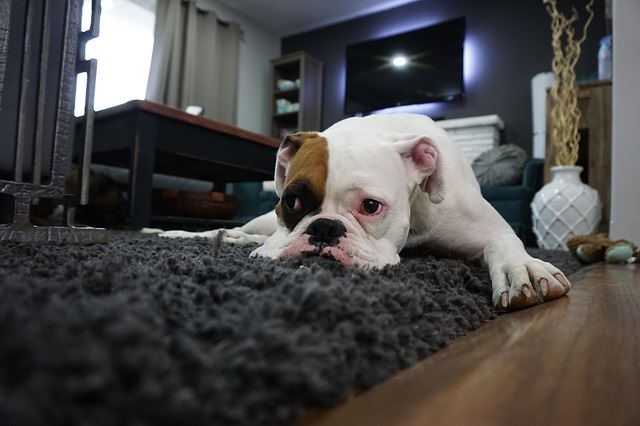
When we clean our homes, we assume we’re making it safer for our loved ones. By getting rid of the microscopic viruses and bacteria that hang around our homes, we’re keeping a clean, healthy environment. But what we use when we clean can have negative effects on our pets’ health if we’re not careful. You wouldn’t leave open containers where your dog could drink them, but those same chemicals can still be harmful to your pets once they’re out of the bottle.

1. Ammonia
It’s likely that you keep products containing ammonia in your home even if you don’t have a big bottle labeled “AMMONIA” under your sink. Ammonia is commonly found in oven cleaners, window cleaners, and wax for hardwood floors. If you have stainless steel surfaces in your home, be aware that it is also found in stainless steel cleaners.
Ammonia can be harmful to both you and your dog as it causes irritation and burns mucus membranes. Several cleaners containing ammonia come in spray-form, so you should wear a mask while using them and your dog should be in another room. Breathing in a cleaner that contains ammonia–or consuming left behind residue–will cause damage to your dog’s nose, mouth and throat. Continued exposure to these harmful chemicals can also lead to respiratory issues. You might begin to notice your dog coughing or otherwise having trouble breathing.
2. Chlorine/Bleach
We use chlorine in bleach, toilet bowl cleaners, disinfectants, and dishwasher detergent. But bleach isn’t poison just to germs, it’s poison to our pets as well. Just inhalation of chlorine can cause kidney and gastrointestinal damage, and consuming chlorine bleach can cause serious poisoning. You may notice coughing, lethargy, vomiting, drooling, diarrhea and seizures, among other symptoms. Be on the lookout for bleached fur around his mouth and nose, and the smell of chlorine coming from him.
It’s important to keep anything containing bleach out of reach of your dog at all times. Don’t trust the foul taste of bleach to stop your dog from eating it – dogs put all kinds of things in their mouths if they are suddenly curious about something.
If you own a pool, the chlorine shouldn’t bother your dog if properly diluted. It may cause a tummy ache if he drinks too much, but it’s not likely to do any major damage. However, you should keep the chlorine tablets for your pool in a closed container and away somewhere that would be impossible for your dog to reach.

3. Glycol Ethers
Glycol ethers are commonly found in all-purpose cleaners, liquid soaps, and spot cleaners. If you want to know if anything in your cabinet contains glycol ethers, look in the ingredients list for “Ethylene glycol,” “propylene glycol,” or “diethylene glycol” – all of which are toxic to your dog if consumed. It may even be inside some containers marked “natural” or “green” so it’s imperative that you check for this.
Glycol ethers have been linked to lung damage, kidney damage, and anemia in humans and animals. According to Pet Poison Helpline, there are three stages of poisoning:
Stage 1: (30 minutes to 12 hours post-ingestion) Similar to alcohol poisoning. Your dog may be uncoordinated, drooling, vomiting, or experiencing seizures. He may also be very thirsty and urinating more.
Stage 2: (12-24 hours post-ingestion) Your dog may appear to get better, but very severe internal injuries are still happening.
Stage 3: (36-72 hours post-ingestion) Severe kidney failure. Your dog may not want to eat, and will be tired, drooling, vomiting, and experiencing seizures or even coma.
Keep your dog occupied in another room away from where you’re using chemicals containing glycol ethers. Clean up any spills quickly.
4. Formaldehyde
It’s not weird if you think of funeral homes when someone mentions formaldehyde. It’s most commonly known as an embalming agent, but we use it around our homes to clean, too. It’s found in soaps, fragrances, general purpose cleaners, and even in some pet shampoos!
Formaldehyde is a severe skin and eye irritant. It also has negative effects on the respiratory and nervous systems of the body. The EPA recognizes formaldehyde as a carcinogen – which means that it can cause cancer, but does not always cause cancer in those who are exposed to it.

5. Quarternary Ammonium Compounds
Also known as “QUATS” – they’re commonly used in fabric softeners, and you may find them in the ingredients list on cleaner labels marked “antibacterial.” They can cause skin irritation, and were found to be one of the leading causes of contact dermatitis in humans over a 10 year study. It’s also thought that they may cause respiratory issues, including asthma in healthy humans.
Dogs can also get contact dermatitis. You may notice skin inflammation and itchiness, blisters and sore patches. He may lose hair, and have lesions or ulcers. Watch out for red patches and scaly, dry, or thickened skin. A vet can treat your dog’s contact dermatitis and relieve his irritation, but it’s important to get rid of whatever might have caused it. You may have to start doing your laundry – especially his bedding – without fabric softener. There are other simple options to keep your clothes static-free. Switch out your fabric softener for a little vinegar – it will do the same job and won’t leave its pungent smell on your laundry.
The post 5 Pet Toxins To Watch Out For In Your Household Cleaner appeared first on iHeartDogs.com.
via Whisker Therapy